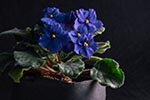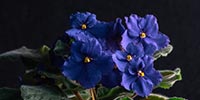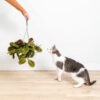Overview
African violets are not poisonous to cats, dogs or other pets and a great option for pet owners who like to have indoor houseplants. They would add a nice splash of color year-round. And their colors imply royalty and trust. We have a section about indoor sensory gardens for people who have indoor cats and want to keep them from suffering l’ennui like a desperate housewife in the early 19th century Romantic era of literature.
So you know, we check the flowers we feature on our site with the ASPCA and do extensive internet research for both the common and scientific name just to be super pet safe. If we cannot find direct reference, we check up to genus and so on until we can confirm whether a plant is toxic or non toxic to both cats and dogs. If we are not sure, or get contradictory information, we do not include it. Many of the plants featured we have grown successfully in our own pet safe garden in Northern California. You can see many of garden stars in photos from Lovie’s Pet Safe Garden.

Physical Attributes
African violets have fuzzy, oval-shaped leaves and small violet-like flowers that bloom in clusters just above the foliage. They grow in a rosette shape and can reach 6-16 inches wide. Flower colors include white, pink, red, blue, and purple.
General Care Tips and Pointers
Grow in well-draining soil formulated for African violets. Provide bright, indirect light. Water thoroughly when the top inch of soil is dry, avoiding leaves. Ideal temperatures are 65-75°F. Remove spent blooms to encourage more flowering. Re-pot every 2-3 years in slightly larger pots.
Fun Facts/Trivia
Despite their name, African violets are not true violets – they were named for their resemblance. They originate from a small region in Tanzania and were discovered in 1892. With proper care, they can live up to 50 years. Their symbolism is devotion and commitment.

| Consideration | Details |
|---|---|
| Container Friendly | Yes, African violets thrive in containers.[1][2] |
| Indoor/Outdoor | Indoor houseplant. A great option for a sensory garden for indoor cats. [2][4] |
| Sun/Shade | Bright, indirect light. No direct sun.[1][5] |
| Perennial/Annual | Perennial[4] |
| Flowering | Small violet-like flowers bloom in clusters above foliage year-round with proper care.[2][4][5] |
| Drought Tolerant | No, prefer consistently moist but well-draining soil.[5] |
| Pollinator Magnet | No, not a major pollinator plant since indoors (maybe a bee could slip in a catio). |
| Beginner Friendly | Yes, relatively easy to care for as houseplants.[2][4] |
| Good Ground Cover | No, compact rosette shape up to 16 inches wide.[3][4] |
| Good Privacy Screen | No, too small in size. |
| Invasive/Spreader | No, not invasive.[1] |
| Dog & Cat Durable | Yes, non-toxic and pet-friendly.[1][2] |
| Rodent Repellent | Unknown |
| Deer Resistant | NA since indoor houseplant away from deer. |
| Native | Yes, native to tropical East Africa.[4][5] |
Citations:
[1] https://www.gardendesign.com/houseplants/african-violet.html
[2] https://www.petittigardencenter.com/plant/african-violets/
[3] https://extension.umn.edu/houseplants/african-violets
[4] https://www.thespruce.com/grow-african-violets-indoors-1902733
[5] https://www.birdsandblooms.com/gardening/flower-gardening/growing-african-violets/





